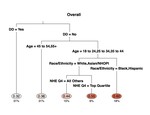Disparities in Health and Outcomes for People with Epilepsy
Disparities and inequities in many disabling and neurological conditions have been understudied – hampering health equity efforts. In response to this need, I lead work that combines traditional statistical approaches as well as novel machine learning techniques to identify inequities among people living with seizures/epilepsy as an exemplar for chronic disabling conditions. This work has identified novel inequities in diagnosis, co-occurring health conditions, specialist care, and pharmacotherapy treatment. This work has uncovered how the confluence of individual-, community-, and structural-level factors influence care and outcomes for patients with epilepsy.
Publications
Disparities in Adherence and Emergency Department Utilization Among People with Epilepsy: A Machine Learning Approach
The Significance of the Increased Incidence of New Onset Seizures and Epilepsy After a COVID-19 Infection
A Framework for Health Equity in People Living with Epilepsy
Trends in Antiseizure Medication Use: Implications for Practice and Clinical Care
Burden of Chronic and Acute Conditions and Symptoms in People With Epilepsy
Objective: People with epilepsy, one-third of whom in the US are on Medicaid, experience a wide range of chronic and physical …
Markers of Quality Care for Newly Diagnosed People With Epilepsy on Medicaid
Background: For newly diagnosed people with epilepsy (PWE), proper treatment is important to improve outcomes, yet limited data exist …
Delays and disparities in diagnosis for adults with epilepsy: Findings from U.S. Medicaid data
Objective: To identify disparities in care pathways and time from first seizure to epilepsy diagnosis, we examined 2010–2014 Medicaid …






